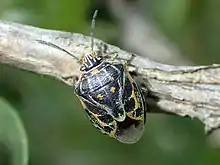| Antestiopsis | |
|---|---|
 | |
| Antestiopsis thunbergii in South Africa | |
| Scientific classification | |
| Domain: | Eukaryota |
| Kingdom: | Animalia |
| Phylum: | Arthropoda |
| Class: | Insecta |
| Order: | Hemiptera |
| Suborder: | Heteroptera |
| Family: | Pentatomidae |
| Tribe: | Antestiini |
| Genus: | Antestiopsis Leston, 1952 |
_upside_down.jpg.webp)


Antestiopsis is a genus of shield bug in the tribe Antestiini: commonly known as antestia or variegated coffee bugs. Several species in eastern Africa are pests of coffee plants, giving the coffee beans a distinctive 'potato taste'.
Species
BioLib includes:
- Antestiopsis anchora (Thunberg, 1783)
- Antestiopsis cederwaldi (Bergroth, 1912)
- Antestiopsis clymeneis (Kirkaldy, 1909)
- Antestiopsis cruciata (Fabricius, 1775)
- Antestiopsis crypta Greathead, 1966
- Antestiopsis faceta (Germar, 1837)
- Antestiopsis facetoides Greathead, 1966
- Antestiopsis falsa (Schouteden, 1912)
- Antestiopsis intricata (Ghesquierei & Carayon, 1948)
- Antestiopsis lepelleyi Greathead, 1965
- Antestiopsis lineaticollis (Stål, 1853)
- Antestiopsis littoralis Greathead, 1965
- Antestiopsis notia (Dallas, 1851)
- Antestiopsis nuba Linnavuori, 1975
- Antestiopsis orbitalis (Westwood, 1837)
- Antestiopsis pallens Villiers, 1956
- Antestiopsis rufovittata (Distant, 1910)
- Antestiopsis thunbergii (Gmelin, 1790)
- Antestiopsis transvaalia (Distant, 1892)
Pest status and control
More than one species is known to be a pest of coffee crops, including A. orbitalis.[1] The 'potato taste' caused by Antestiopsis attacks is thought to be caused indirectly by bacteria entering through wounds created by the insects, leading to an increase in the concentration of isopropyl methoxy pyrazine.[2][3] They feed on flowers, berries and growing tips, injecting a toxic saliva that often contains the spores of the Ashbya fungus, and then suck juices out.[4]
Historically, Antestiopsis has been controlled in Kenya using pyrethrum powder (and may still be used for organic production).[5] Subsequently, the organophosphate fenthion was used to control the pest in Burundi,[2] but this is no longer permitted for important markets such as the European Union.
Laboratory experiments have found the essential oils of Thymus vulgaris, Ruta chalepensis and Chenopodium ambrosioides cause around 90% mortality in Antestiopsis.[6]
References
- ↑ Antestiopsis Plantwise
- 1 2 B. Bouyjou, B. Decazy & G. Fourny (1999). "L'élimination du " goût de pomme de terre " dans le café Arabica du Burundi" [Removing the "potato taste" from Burundian Arabica]. Plantations, Recherche, Développement (in French). 6 (2): 107–115.
- ↑ Czerny, M.; Grosch, W. (2000). "Potent Odorants of Raw Arabica Coffee. Their Changes during Roasting". Journal of Agricultural and Food Chemistry. 48 (3): 868–872. doi:10.1021/jf990609n. PMID 10725165.
- ↑ Jean Nicholas Wintgens (2009). "Coffee Pests in Africa". Coffee: Growing, Processing, Sustainable Production (2nd ed.). pp. 433–435. ISBN 978-3-527-32286-2.
- ↑ Crowe, T. J.; Jones, G. D. Glynne; Williamson, Ruth (2009). "The use of pyrethrum formulations to control Antestiopsis on coffee in East Africa". Bulletin of Entomological Research. 52: 31–41. doi:10.1017/S0007485300055267.
- ↑ Mendesil, Esayas; Tadesse, Mekuria; Negash, Merid (2011). "Efficacy of plant essential oils against two major insect pests of coffee (Coffee berry borer,Hypothenemus hampei, and antestia bug,Antestiopsis intricata) and maize weevil,Sitophilus zeamais". Archives of Phytopathology and Plant Protection. 45 (3): 366–372. doi:10.1080/03235408.2011.587286. S2CID 84439876.
External links
 Data related to Antestiini at Wikispecies
Data related to Antestiini at Wikispecies Media related to Antestiopsis at Wikimedia Commons
Media related to Antestiopsis at Wikimedia Commons
